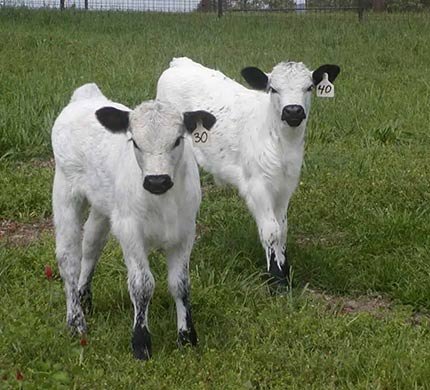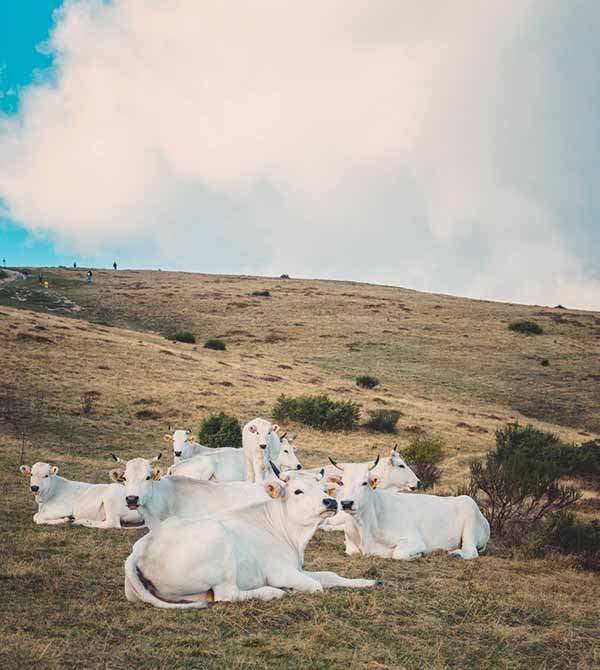White Park Cattle
- Temperature:40°F and 60°F
- Milk:1 to 4 gallons per day
- Food:Pasture, Hay and Grain
- Pregnancy:283 days
- Nationality:British Isles

General Information
White Park cattle are a breed of ancient, horned cattle that originated in the British Isles. They are also sometimes known as Park cattle, Whitehorn cattle or Ancient White Park cattle. They are named after their distinctive white coloring and their association with parklands.
White Park cattle are a medium-sized breed, with cows weighing around 1,000-1,200 pounds and bulls weighing up to 2,000 pounds. They have a characteristic white coat, which can range from pure white to off-white or light gray. They also have black or dark-colored skin, eyes, and hooves.
White Park cattle are known for their hardiness and adaptability to a variety of climates and environments. They are also known for their docile temperament and are often used for conservation grazing in parks and nature reserves.
Where we find this cow to buy?
White Park cattle can be purchased from various sources, including breeders, farmers, and livestock auctions. Here are some ways to find White Park cattle for sale:
01. White Park Cattle Association : The White Park Cattle Association maintains a directory of breeders who are members of the association.02. Livestock auctions : Check out livestock auctions in your area. White Park cattle may be sold at these auctions, and you can find them by contacting the auction house or checking their website.03. Online livestock marketplaces : There are online marketplaces that specialize in buying and selling livestock.
When purchasing White Park cattle, be sure to ask the seller about the animal’s health history, lineage, and any relevant certifications or paperwork. You should also ensure that the animal is appropriate for your needs and that you have the appropriate facilities and resources to care for it properly.

How to increase milk production in White Park Cattle
There are several ways to increase milk production in White Park cattle. Here are some tips:
01
Good nutrition is essential for milk production in cattle, so ensure a balanced diet with hay, pasture, and a feed mix formulated specifically for lactating cows.
02
Selecting cows with high milk-producing genetics can increase milk production.
03
Establish a regular milking routine and stick to it. Milking should be done at the same time each day and in a clean, hygienic environment to prevent infection.
04
Cows need access to clean, fresh water at all times, especially when lactating.
Medicine
There are different types of medications that can be used to treat various health conditions in cattle, including White Park. Some common types of medications for cattle include:
01
AntibioticsTreatments for bacterial infections such as mastitis, respiratory infections, and gastrointestinal infections.
02
AntiparasiticsThese are used to treat and prevent external and internal parasites such as lice, mites, ticks, and worms.
03
VaccinesAntibodies are given to cattle to stimulate their immune system to produce protective antibodies.
04
HormonesCows use hormones to regulate reproductive cycles and increase milk production or synchronize estrus cycles for breeding purposes.
Pregnancy
Nutrition is essential during pregnancy, and a nutritionist or veterinarian can help develop an appropriate feeding program to meet the needs of the cow.
Preparing for calving involves monitoring for signs of labor, providing a clean and dry area, and assisting the cow during the calving process if any difficulties arise.
Regular health checks by a veterinarian are important to ensure that the cow remains healthy during pregnancy. Any health issues should be addressed promptly to prevent any adverse effects on the calf.
After calving, the cow and calf should be monitored closely for any health issues. The cow should receive proper nutrition and care to ensure that she can produce enough milk for the calf.
Important!
Proper nutrition, vaccinations, health management, calving preparation, and postpartum care are all important factors during the pregnancy of White Park cattle. Regular veterinary care and close monitoring can help ensure a successful pregnancy and a healthy calf.
Food
White Park cattle, like all cattle, are herbivores and primarily eat forage, such as hay, silage, and pasture. The quality and quantity of forage can affect the growth, health, and productivity of White Park cattle. In addition to forage, cattle may also be fed supplemental grains, such as corn, barley, and soybeans, to provide additional nutrients and energy.
Good quality forage is essential for the health and productivity of White Park cattle. Forage should be free of mold, dust, and other contaminants and should be properly stored to prevent spoilage.
Cattle require plenty of clean, fresh water for digestion, metabolism, and body temperature regulation. Ensure that your White Park cattle have access to clean, fresh water at all times.
Nutritionists can help develop a feeding program that meets the specific nutritional needs of White Park cattle, depending on their stage of production.
Cattle should be fed on a regular schedule to promote good digestion and prevent digestive upsets. Feeding times should be consistent from day to day.
Facts
White Park is a heritage breed of cattle that originated in the British Isles. Here are some interesting facts about White Park cattle:
White Park cattle are a large, muscular breed with a distinctive appearance. They have long, curved horns, and their coat color ranges from white to silver-grey with black or dark red markings.
White Park cattle have a long and rich history, dating back to prehistoric times. They were used for meat, milk, and draft work and were highly valued for their hardiness and adaptability.
White Park cattle are well adapted to a variety of environments, including harsh and rugged terrain. They are hardy and can tolerate both hot and cold temperatures, making them a good choice for a range of climates.
White Park cattle are considered a dual-purpose breed, meaning that they are suitable for both meat and milk production. They are known for their flavorful beef and high-quality milk, which has a high butterfat content.
White Park cattle are currently listed as a “vulnerable” breed by the Livestock Conservancy, a nonprofit organization dedicated to preserving heritage livestock breeds. There are believed to be fewer than 1,000 breeding animals worldwide.
Organizations are working to conserve and promote White Park cattle, including the Rare Breeds Survival Trust and Livestock Conservancy, to preserve the genetic diversity and cultural heritage of this unique breed.